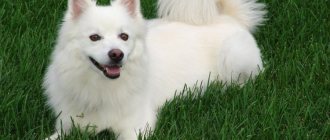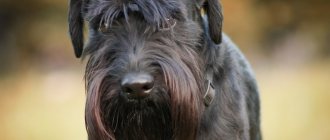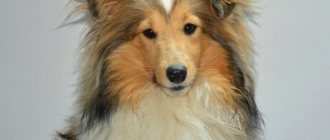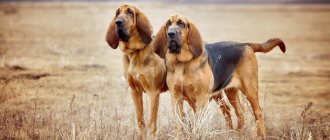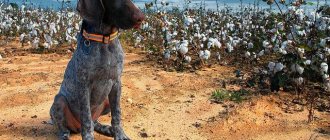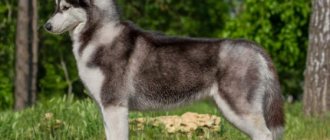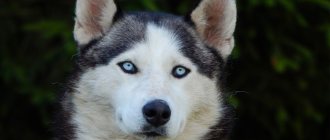The Norwegian elk husky gives a deceptive impression. Only connoisseurs of the breed will recognize a fearless, strong hunter in a fluffy, pretty dog. Meanwhile, it is these features that must be taken into account when choosing a pet. This is the only way to create the conditions necessary to maintain a representative of this wonderful breed.
Brief history of origin
The Norwegian Husky is one of the oldest breeds in Scandinavia. In Norway, the animals have been used for centuries to hunt moose - the official name "elkhund" is translated from Norwegian as "elk dog". However, who her ancestors were remains a mystery.
In 1877, huskies took part for the first time in an exhibition organized by the Norwegian Hunters' Association. Two years later they were recognized by the Norwegian and Swedish Kennel Clubs.
Initially, all dogs were exclusively gray. Only at the beginning of the 20th century, Norwegian breeders developed a new variety - the black husky, which differs only in color and size. The FCI recognized both species in 1955.
Survey of the month
Who is smarter than a cat or a dog?
Read the expert opinion here
Liked? Please rate the article!
To main
Having become a national treasure and one of the symbols of Norway, a true northern treasure, the Norwegian Laika, or Elkhound, embodies the idea of an intelligent, fearless, hardy, almost ideal hunting dog. Everything about it deserves admiration and respect: the centuries-old history of the breed, rare working qualities, extraordinary devotion to people.
Norwegian Husky
Interesting Facts
Quite little is known about Norwegian moose huskies, but several interesting facts are still associated with them:
- The elk husky belongs to the group of primitive breeds, but this characteristic does not apply to intellectual abilities. This is the name given to animals that have formed naturally with minimal human intervention.
- The remains of a dog resembling a modern moose husky were discovered in the Norwegian Vist Cave. The find dates back to the Bronze Age, that is, it is about 5-6 thousand years old.
- Norwegian Elkhunds were faithful companions of the Vikings. Skeletons of dogs are often found near the graves of their owners.
Activity
The Norwegian Elkhound is not a breed that is suitable for living in an apartment. She needs physical activity and a large space, so it is best if the animal has a large fenced yard at its disposal. The dog will feel great on a farm, where he will have a lot of familiar work.
The Elkhound is a wonderful companion. Dogs of this breed have proven themselves well in protection, they are excellent watchmen, they herd livestock very skillfully, and when harnessed to a sleigh, they can transport loads.
Due to the thick, fleecy undercoat, the dog can hardly tolerate the heat, and on frosty winter days and even in inclement and rainy weather, it feels very comfortable. On summer days, the Elkhound loves to swim and hides from the sun's rays in a shady place.
Breed description, standards and appearance
The Norwegian Elkhound looks like a typical husky. The gray variety is proportionally built, has a short, square body and abundant hair. She is assessed according to the ICF standard No. 242.
Physical parameters are strictly regulated.
Ideal height:
- for boys - 52 cm;
- for girls - 49 cm.
Deviation from the specified parameters by more than 3–4 cm is a disqualifying defect. Weight usually ranges from 20–25 kg. The main condition is the harmonious appearance of the animal.
The black elkhound is built a little lighter and more gracefully, but its coat is just as thick and dense. Its characteristics are given in the ICF standard No. 268.
The black husky is slightly smaller than the gray one: the height of boys is 46–49 cm (ideally 47 cm), girls – 43–46 cm (ideally 44 cm).
The dog can be 3 cm below or 4 cm above the ideal parameters. Average weight – 15–20 kg.
Description of the breed (ICF standard):
- The skull is wide and wedge-shaped. The cheekbones are well defined. The stop is moderately pronounced.
- The muzzle is cone-shaped and straight. Its length is approximately equal to the distance from the stop to the occipital protuberance.
- The lobe of both black and gray huskies is always black.
- The lips fit tightly to the jaws, closed in a scissor bite. Undershot or overshot are disqualifying faults. There are exactly 42 teeth.
- The Norwegian Laika's eyes are oval and not protruding. The pigmentation of the iris is dark brown. Gray huskies with yellow or blue eyes are disqualified.
- The ears are compact, located high on the head, look straight, but move perfectly in different directions. Their height is slightly greater than the width of the base. The tips are pointed. Drop ears are grounds for disqualification.
- The neck is medium size and strong. Covered with thick fur. There is no suspension.
- The body is strong and muscular. The withers are clearly defined. The back is level, the loin and croup are wide.
- The chest is voluminous. The stomach is only slightly tucked in - the bottom line looks almost straight.
- The tail of the moose husky is located quite high, covered with thick, but not excessively long fur. Twisted into a tight ring and thrown onto his back. The Norwegian elk never hangs it to the right or to the left. Short-tailed dogs are disqualified.
- The limbs are athletic and strong, parallel to each other. Shoulders moderately sloping, hips wide apart. The paws are quite small, oval.
Both black and gray moose huskies have a dense coat that is rough to the touch. The spine is smooth, without curls. The longest fur covers the neck, hips, back of the legs, and tail; the hair on the body is medium, and the hair on the head and front of the limbs is short. The undercoat is thick and soft.
The color of the gray elk husky combines any shades of gray, however, the tips of the outer hair are always black. On the lower part of the body, the fur is slightly lighter; in the front part of the body, light stripes form a kind of harness. There is a dark mask on the head. The undercoat is always light gray. Dogs of other colors are disqualified.
The black moose husky is only allowed to have a black color. The undercoat should also be black. A small amount of white hair on the chest and legs is not considered a fault. A light mark on the chest or a spot on the tail is considered a fault.
A detailed article about Laika dogs is here.
Diseases of the Norwegian elk husky
Norwegian Elkhounds are strong and healthy dogs with an average life expectancy of 12–15 years. They do not have any specific ailments, but, like all large and medium-sized breeds, there is a risk of hip dysplasia. This is a hereditary disease associated with failures in the formation of joint elements, as a result of which they lose their functionality. The first symptoms usually begin to appear by 6 months of age and later as the pet gains weight. Typical manifestations of the problem are:
- difficulty getting up on your feet after sleep;
- lameness after exercise;
- increased fatigue;
- decrease in usual activity;
- negative reaction of the animal when trying to touch the hind paw.
The disease requires mandatory consultation with a veterinarian. Conservative therapy rarely produces results, so surgery to install prostheses is most often prescribed.
Character and behavior
The Norwegian Elk Husky is a brave, agile, determined dog. The breed has a stable psyche, so it is not characterized by hysteria, cowardice or aggression. The dog is friendly towards all people, but in case of an obvious threat it is ready to defend its owner.
Norwegian moose huskies are especially prized for their hunting qualities. Trained animals work independently, without waiting for human prompting. Their task is to hold the animal until the hunter arrives. Several dogs cope not only with elk, but also with lynx, wild boar and even bear.
On a note. The black Norwegian husky is somewhat more energetic and temperamental. Otherwise, both varieties are absolutely identical.
The pet's character has all the traits of a good companion. The moose husky becomes very attached to humans; when buying an adult dog, adaptation difficulties may occur. The breed is jealous, which makes it difficult to keep it with other pets. The Elkhound gets offended if its owner pays attention to someone else. An exception may be animals that grew up with the dog.
The Norwegian Elk Husky is good with children and forgives them many pranks and excessive intrusiveness. She understands that children are weak and vulnerable, so she tries in every possible way to protect them. For teenagers, the Elkhound will be an excellent playmate - cheerful and tireless.
Expert opinion
Leonid Rodin
Experienced dog breeder
Ask a Question
Scandinavians love their national dogs and always emphasize their ancient origins. Indeed, when communicating with the Norwegian Elkhound, one can conclude that over the past dozens of centuries it has hardly changed. At least, irrepressible movement and passion for hunting still prevail in the behavior of these huskies. But in modern conditions, when owners no longer hunt game for food, but keep Norwegian dogs for their own pleasure, the working qualities of huskies need some other outlet. They make excellent search and rescue team specialists or even guide assistants for people with disabilities. Interestingly, in Norway there is still a law according to which, in the event of war, the Minister of Defense has the authority to mobilize all Elkhunds in private hands for military service.
Key points in training
Norwegian Huskies are inquisitive and enjoy participating in training. The course of basic commands can be started from 2-3 months. Training is best done in the form of a game, or with food reinforcement. You should not make training long, as the dog may lose interest. Particular attention should be paid to the command “Come to me!” and the fight against barking.
Read about how to properly train a dog in the article: “Training a puppy: effective methods from dog handlers, learning commands at home.”
How to choose the right puppy?
The Norwegian elk husky is an infrequent visitor to Russia. There are very few nurseries, so fans of the breed often bring animals from abroad. However, on the Internet you can find many advertisements for the sale of black or gray Elkhound. The purity of the puppies offered is highly questionable. The majority of dogs do not have documents - no one guarantees their breed and health.
On a note. Black huskies are rare even in their homeland.
When choosing a puppy, you should first talk to the breeder, meet the baby’s parents and study their pedigree.
Signs of healthy pets:
- shiny wool;
- clean eyes and ears;
- no unpleasant odor;
- lively look;
- cool and moist nose;
- correct bite;
- mobility, curiosity, playfulness.
The breeder's readiness to conclude a purchase and sale agreement is evidenced in favor of the breeder. The document insures the future owner against acquiring a Norwegian elk husky with obvious defects. Together with the puppy, the new owner receives a passport with a note on vaccinations and a metric, which is subsequently changed to a pedigree.
About raising a hunter
The little Elkhound needs early socialization. After the necessary vaccinations, do not delay his introduction to the outside world and other animals, sometimes take him on public transport, let the baby learn new smells.
The Elkhound is smart, independent and even stubborn at times. Therefore, when learning commands with him, you will need to be patient, because you will have to repeat everything several times
Behave gently but decisively, and most importantly, arouse the dog’s interest
This dog needs to use energy. He will happily join his owner for a jog or bike ride, and will also take part in various dog competitions.
If you want to develop hunting skills in your pet, then it would be better to turn to dog handlers who know how to do it correctly.
Puppies
Norwegian Elkhound puppies begin to be fed at 1–1.5 months.
The first foods given to babies are:
- milk;
- egg yolk;
- minced meat;
- zucchini and carrots.
At 8 weeks, the pet is usually handed over to new owners - the nuances of nutrition are discussed in advance with the breeder. Milk and meat porridges are cooked for small moose huskies. It is allowed to give semolina if there is a lack of weight. Whole milk is gradually being replaced with fermented milk products.
At 3 months, the Norwegian elk husky’s gastrointestinal tract copes with different types of food - the menu is enriched with sea fish, after 2-3 weeks they try to give offal. With the beginning of teeth change, the amount of food rich in calcium is increased. To speed up the process, children are allowed to gnaw on brain bones.
At six months, puppies are fed almost the same as adult moose huskies. However, there should be more protein food as pets gain muscle mass and continue to grow. Meat can be given raw, after freezing it to kill parasites.
The frequency of feeding depends on age:
- 1–2 months – 6 times a day;
- 2–3 months – 5 times a day;
- 3–5 months – 4 times a day;
- 5–9 months – 3 times a day.
As the year approaches, Norwegian moose huskies are switched to two meals a day.
What to feed?
A good diet is considered the basis of a healthy lifestyle and health. In order to protect your Norwegian Husky from allergies, it is worth remembering that he should not be given food from your table. Prohibited products include the following:
- sausage and smoked meats;
- saltiness and spicy foods;
- sweets, in particular chocolate;
- small seeds;
- bakery products;
- pasta.
Top articles : Toilet for cats: how to choose the best one
Meat and meat products should be given to the dog boiled, so you can be sure that it does not contain dangerous microorganisms. Raw vegetables and fruits must be thoroughly washed before serving to the dog. You can also feed your pet porridges, such as buckwheat and rice. The Norwegian diet should include sea fish, dairy products, eggs, vegetable fat, offal and greens.
Nutritional Features
The Norwegian Laika is one of the most undemanding hunting dog breeds to keep. This is explained by the way of life of Elkhounds, which has been formed over centuries, which is characterized by constant restriction of food. But this does not mean that the dog’s diet should be meager and primitive: constant poor nutrition has a negative effect on the health, working qualities, and appearance of the animal. What type of food - natural or ready-made industrial - to give preference to is decided by the dog owner, based on his capabilities.
Natural and dry food
If dry food is chosen as the main diet, it should not be lower than the “premium” class. The best choice for regular nutrition are ready-made diets of the “super premium” and “holistic” classes, which comprehensively take into account the age characteristics and physiological status of the dog. They do not contain synthetic components; in addition to the necessary nutrients, balanced in qualitative and quantitative composition, their formula includes vitamin and mineral supplements.
In addition to the class of food, its labeling is important: during periods of heavy workload or competition, it is advisable to purchase food for the Elkhound with the inscription “Energy” on the packaging.
Experienced breeders believe that natural food is preferable for dogs of aboriginal working breeds. In this case, the basis of the daily diet of an adult animal is:
- proteins - 400 g;
- complex carbohydrates - 350 g;
- animal fat - 15 g;
- fiber - 150-200 g.
It should be taken into account that the content of components must be adjusted depending on the time of year:
Norwegian Husky in winter
- in winter, to compensate for increased energy costs, the proportion of protein is increased and the amount of fiber is reduced;
- in the summer, when appetite is reduced, more sources of fiber are added to the dog’s menu - vegetables, berries, fruits.
It is recommended to finely chop all products intended for feeding the Elkhound: in this way, the prepared food is digested faster and better, and the dog will be able to be active almost immediately after eating. The volume of a single serving in normal mode should not exceed 3% of the weight of the dog itself.
This average amount of food increases by about 1/3 when going hunting. In order for the pet to develop normal eating behavior, they resort to regimented feeding: an adult Norwegian husky is usually fed 2 times a day. Regardless of the type of diet chosen, clean water should always be available to the dog.
Care and maintenance
The best habitat for both black and gray moose huskies is a country house with a large plot. Animals are accustomed to living in freedom, and limited space greatly oppresses them. If a person nevertheless decides to have an Elkhound in an apartment, he will have to devote at least three hours a day to active walks.
The elk husky should have a kennel in the yard where it can shelter from bad weather. It is prohibited to keep freedom-loving animals on a chain. This approach is fraught with mental disorders, the emergence of unmotivated aggression and distrust of people.
The right diet
The Norwegian elk husky is not a picky eater and does not have any particular taste preferences. The diet of both gray and black elkhund can consist of ready-made food or natural food.
In the first case, pets are bought high-quality premium, super-premium or holistic products. Cheap food contains artificial additives and ballast substances, and therefore inevitably leads to health problems.
Many breeders believe that natural nutrition is preferable for primitive breeds. Then moose huskies are given lean meat (beef, rabbit, chicken and turkey) and offal - they account for 40–50% of the total food. The rest of the diet is formed from:
- rice, buckwheat and millet porridges;
- fermented milk products;
- vegetables and fresh herbs.
Once a week, Norwegian elk huskies are given sea fish and chicken eggs. In winter, when animals require more energy, the amount of protein food is increased.
Important. The serving should not be more than 3% of the pet’s weight.
Walking and physical activity
Even if kept outdoors, a moose husky must be taken outside twice a day. The duration of exercise should be at least 1 hour. The dog will be happy to go into nature - to the forest or to the shore of a reservoir. She will happily accompany her owner on a jog, bike ride or hike.
On a note. On the street, the Norwegian elk dog may chase a cat or other small animal.
Training and education
The Norwegian Elk Husky is intelligent, but can be quite difficult to train. This is due to independence and willfulness - the pet will not blindly follow commands. In order to raise a manageable and obedient animal, training begins immediately after the puppy appears in the house.
The baby is not touched for a couple of days so that he gets used to the new environment and gets to know the owner.
After this he is taught:
- come when called;
- wear a collar and leash;
- observe standards of behavior and not violate prohibitions;
- sleep on a couch.
When the vaccination quarantine ends, the Norwegian elk husky is taken outside and actively socialized. The dog should not be afraid of city noise, strangers and unfamiliar animals. More and more busy streets are chosen for walks, constantly changing routes so that the pet gets a complete picture of the world around him.
On walks and during games, the Norwegian elk husky learns the commands “Come to me!”, “You can’t!”, “Ugh!”, “Place!”. At 3–4 months, she is taught to sit and lie down on command, and to walk next to her owner on a loose leash. Over time, the lessons become more complicated, supplementing orders with gestures and endurance training.
You need to talk to the puppy more in a friendly tone. If the pet is stubborn, the intonation is changed to strict, and they achieve what they want without the use of violence. The child is sincerely praised for correct actions. Treats provide additional motivation. And although the Norwegian Laika is a hunting breed, it will be useful for it to undergo OKD.
On a note. There is an opinion that the black husky is more obedient.
Dogs that are planned to be used for hunting begin to be trained in the field at six months. It is better to do this in the company of experienced dogs, since the Norwegian Elk Husky has a developed imitative instinct. Trained puppies become good hunters at 8–10 months.
Read more about training a husky in our article “Training a husky.”
Care and hygiene
Black and gray moose huskies require minimal hygiene. Coat care comes down to weekly brushing. During the molting period, the fur is treated with a slicker every 2-3 days.
The Norwegian moose dog is quite clean - it will not step in puddles, roll in the mud or dig through garbage. Its coat is capable of self-cleaning, so bathing is required in exceptional cases.
Ears are cleaned once a week, eyes are wiped with an antibacterial solution when discharge appears. The claws are trimmed as they grow, if the Norwegian elk husky does not grind them down on his own. To maintain dental health, she is given large bones or dental treats to chew on.
Some dog breeders clean the dog with a special brush and veterinary paste about once a week.
Nutritional Features
What kind of diet should a moose husky from Norway have? The menu of representatives of the hunting breed should be balanced. When choosing a diet, it is worth considering that the dog expends a large amount of energy. If you want to purchase ready-made food, you should give preference to products that are of high quality.
In the case when the menu consists of natural products, it is important that the dog’s diet contains a sufficient amount of:
- boiled sea fish;
- offal;
- chicken and turkey fillet;
- rice, buckwheat and oatmeal;
- kefir;
- cottage cheese.
Advice! When creating a diet for an Elkhound, it is worth remembering that representatives of this breed are prone to obesity. You should not overfeed your pet, monitoring the size of its portion each time.
The basis of the diet for children should be porridge with turkey meat
Vaccinations and susceptibility to disease
Moose husky puppies - both gray and black - are vaccinated according to the standard schedule.
At 8–9 weeks, babies are vaccinated against the following diseases:
- plague;
- parainfluenza;
- leptospirosis;
- viral hepatitis;
- parvovirus enteritis.
After approximately 21 days, the animals are revaccinated. The rabies vaccination can be done at the same time, or, if there is no threat of infection, it can be postponed until after the change of teeth. Adults are vaccinated every year and treated against worms, fleas and ticks every 3 months.
Pros and cons of the breed
| Advantages | Flaws |
| Friendly character | High activity |
| Devotion | Inability to live in an apartment |
| Unpretentiousness | Self-will |
| Good health | Heavy shedding |
| Good attitude towards children | |
| Quick wits | |
| Acute vision, hearing and sense of smell |
The Norwegian Elk Husky is a first-class hunter and an excellent companion, but it is only suitable for an energetic person.
Homebodies and owners of small apartments should take a closer look at the less active breed.
